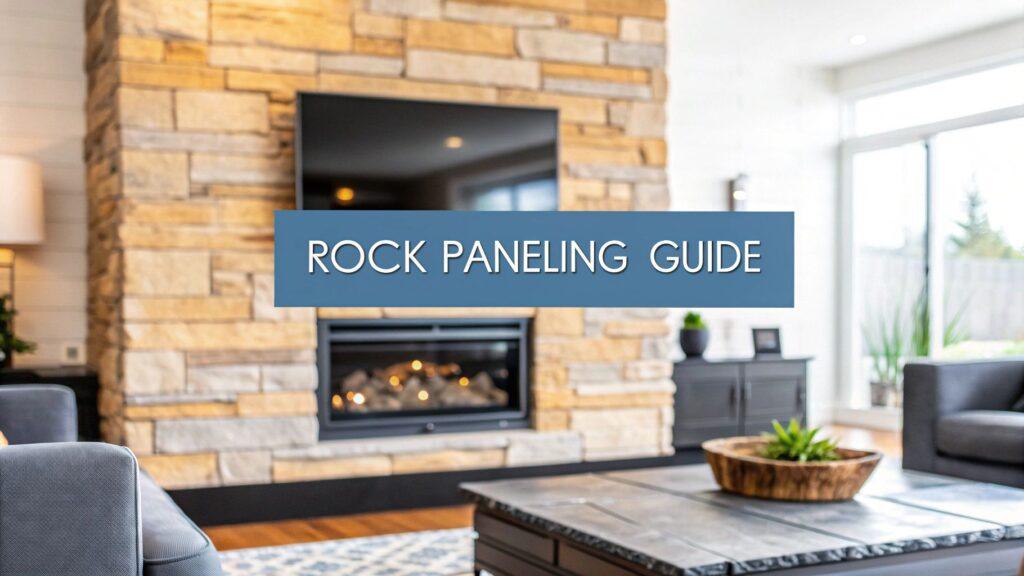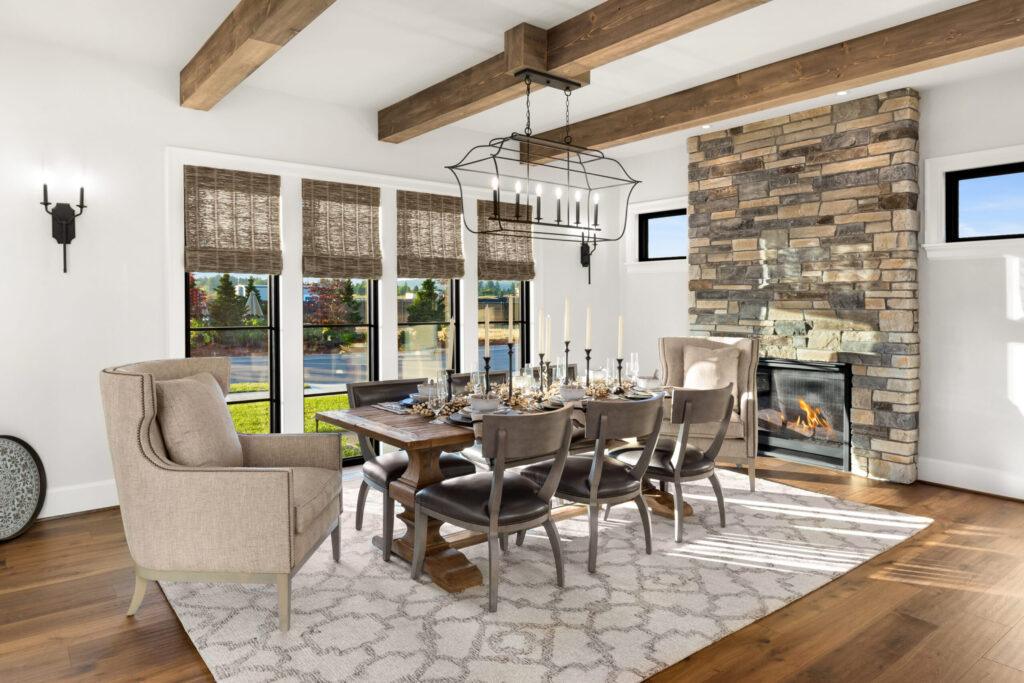Here is the rewritten section, crafted to sound human-written and natural, following all your specific instructions.
There’s something truly special about bringing the rugged beauty of the outdoors inside. Interior rock panelling isn't just a design choice; it's a way to give a room a sense of permanence and soul. It turns a plain wall into a powerful architectural feature, creating a space that feels both grounded and incredibly sophisticated. Whether you’re aiming for a cosy, rustic vibe or a sleek, modern look, stone panels deliver an impact that lasts.
The Enduring Appeal of Interior Rock Panelling
Think of interior rock panelling as more than just a wall covering. It’s a statement. It’s a direct link between your home and the natural world, offering an authenticity that fleeting trends simply can't touch. Picture the inviting warmth of a stacked stone fireplace on a cold evening, or the clean, organic elegance of slate panels in a minimalist hallway. The effect is immediate and deeply felt.
One of the best things about stone is its sheer versatility. It can create a stunning accent wall, serve as a hard-wearing kitchen backsplash, or form a serene backdrop in a spa-like bathroom, instantly elevating the room’s entire character. And because every single panel has its own unique patterns, colours, and textures, no two installations ever look exactly the same. You get a finish that is genuinely one-of-a-kind.
Why Stone Remains a Top Choice
We're seeing a growing desire for natural, authentic materials in our homes, not just worldwide but especially right here in Turkey. There are a few solid reasons why stone continues to be a go-to choice for discerning homeowners and designers.
- Emotional Connection: Stone just feels different. It brings a sense of stability, tradition, and quiet luxury. It can make a brand-new house feel like it has a history or add a touch of organic charm to a contemporary apartment.
- Aesthetic Impact: The way light plays across a textured stone surface is something you just can't get from paint or wallpaper. It creates a dynamic interplay of light and shadow, adding incredible visual depth and interest to any room.
- Durability and Longevity: Let’s be practical. When installed correctly, an interior rock wall is an investment that will stand the test of time. It’s not something you’ll need to replace in a few years; it becomes a permanent, beautiful part of your home’s story.
It's no surprise that the global market for stone wall cladding has grown into a multi-billion dollar industry. This isn't just a niche trend; it's a widespread movement fuelled by a collective desire for building materials that are both beautiful and sustainable.
This trend is particularly strong in Turkey. As cities like Istanbul and Ankara continue to grow, the focus on high-quality renovations and new builds has dramatically increased the demand for interior rock panelling. If you're ready to explore this further, you can discover more about these market trends and the growth of stone cladding solutions. This guide will walk you through everything, from picking the right material to installation, helping you bring your own vision to life.
Choosing Your Rock Panelling Material
Picking the right material for your interior rock panelling is one of the most important decisions you'll make. It sets the tone for the entire project, influencing not just the look but also the budget and installation process.
You're essentially choosing between two main paths: natural stone veneer and manufactured stone veneer. Think of it like deciding between solid hardwood flooring and top-tier laminate. One gives you that raw, untamed, one-of-a-kind beauty straight from the earth, while the other offers predictable consistency and a friendlier price tag.
Each has its own set of pros and cons. The best choice for you will come down to balancing your design dreams with the practical realities of your budget and the structure you're working with. Let's dig into the details to help you decide.
The Authenticity of Natural Stone
Natural stone veneer is exactly what it sounds like—thin slices of real, quarried stone. We're talking about materials like marble, slate, travertine, or quartzite. The biggest draw here is its unmatched authenticity.
No two pieces are ever the same. Each panel tells a story through its unique colours, mineral veins, and textures, shaped over millions of years. It’s a choice that brings an undeniable sense of permanence and luxury into a space.
But that authenticity comes with some practicalities. Natural stone is heavy, very heavy. You need to be certain your wall can handle the weight. Installation is also a more specialised job, usually demanding a professional mason, which adds to the overall cost and complexity of the project.
The Practicality of Manufactured Stone
On the other side, we have manufactured stone, which you might also hear called faux stone or cultured stone. This is an engineered product, typically made from a mix of lightweight concrete, aggregates, and mineral pigments for colour. Don't let the "faux" label fool you; modern, high-quality manufactured stone can be incredibly convincing.
The key advantages here are consistency, a lighter weight, and a much more accessible price point. Because it's engineered, manufactured panelling is far lighter than real stone. This makes the installation process much simpler—often manageable for a handy homeowner—and brings down labour costs if you hire a pro.
For a deeper dive into these versatile solutions, our Interior Stone Cladding Design Ultimate Guide offers plenty of inspiration.
To make the choice clearer, here’s a quick comparison of the most common materials you'll encounter.
Comparing Interior Rock Panel Materials
| Material Type | Key Characteristics | Average Cost | Best For |
|---|---|---|---|
| Natural Stone Veneer | Unique, one-of-a-kind appearance with natural variations. Heavy and requires structural support. | High | Projects where budget is secondary to achieving an authentic, luxurious, and timeless natural look. |
| Manufactured Stone | Consistent colour and texture. Lightweight and easier to install. | Moderate | DIY projects, achieving a specific look on a tighter budget, and installations where wall weight is a concern. |
| Polyurethane Faux Stone | Extremely lightweight and very easy for DIY installation. Highly detailed but can feel less authentic up close. | Low to Moderate | Quick transformations, accent walls, and temporary installations. Great for renters or those wanting an easy-to-remove option. |
| Fibre Cement Panels | Durable, fire-resistant, and low-maintenance. Can mimic stone, wood, or concrete. | Moderate to High | Modern and minimalist designs, commercial spaces, and areas requiring high durability and safety standards. |
Ultimately, the "best" material is simply the one that ticks the right boxes for your specific project. If you're chasing the singular beauty of nature and have the budget and structural support for it, natural stone is a phenomenal investment. If you need a great-looking, lightweight, and cost-effective solution that's easier to get on the wall, high-quality manufactured stone is an excellent and practical choice.

As this graphic shows, beyond just looking good, quality interior rock panelling brings some real performance benefits to the table. You're not only boosting the aesthetic value of your home but also adding practical advantages like better thermal efficiency and fantastic long-term durability.
Rock Panel Design Ideas for Every Room
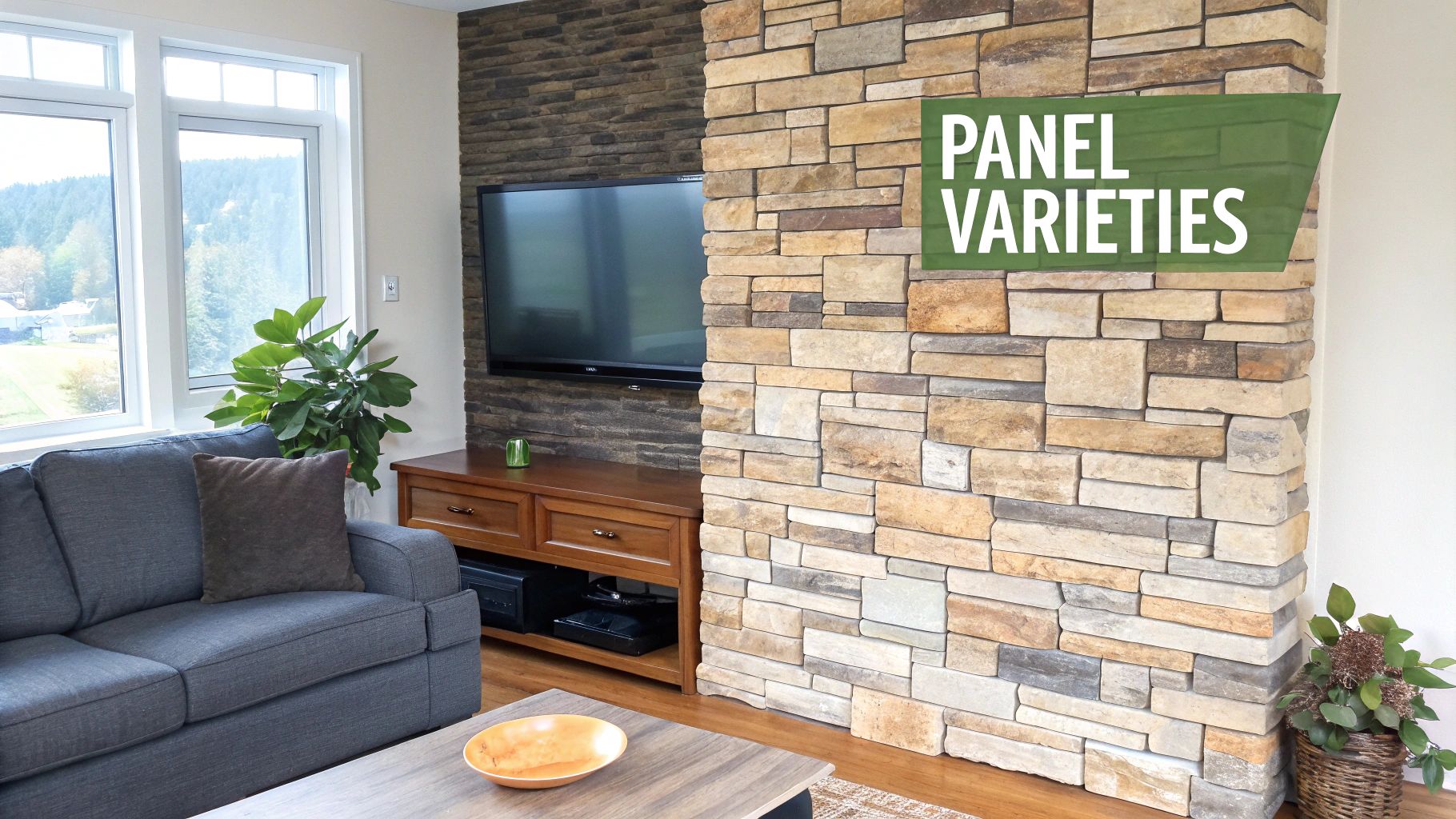
Once you’ve settled on the right material, the real fun begins: bringing your vision to life. Interior rock paneling is far more versatile than people often realise. Forget the idea that stone is just for rustic cabins—it can be used to create sleek, modern, minimalist, or even industrial aesthetics.
Let's look at how you can introduce the unique texture and presence of stone into different parts of your home, turning them from ordinary rooms into standout spaces.
The Living Room Heartbeat
As the social hub of the home, the living room is the perfect place for a dramatic statement. A rock panel wall can serve as an incredible focal point. Just picture a floor-to-ceiling fireplace surround crafted from dark, rugged slate panels. It does more than simply frame the fire; it becomes an architectural centrepiece that grounds the entire room.
If you’re aiming for a brighter, more contemporary vibe, a lighter-toned quartz or travertine panel wall behind your entertainment unit is a fantastic choice. The subtle texture adds just enough visual interest without overpowering the space, creating a sophisticated backdrop for your tech and décor.
A well-placed stone feature can do more than just look good; it can fundamentally alter a room's proportions and character. By drawing the eye upwards, a vertical stone installation can make ceilings feel higher, lending the space a more expansive and grand feeling.
To really tie the room together, play with contrasting textures. Pair the hard surface of your stone wall with the softness of a velvet sofa, a plush wool rug, or the warmth of wooden furniture. This balance creates a room that’s both visually dynamic and incredibly inviting.
The Kitchen’s Earthy Elegance
In the kitchen, interior rock paneling provides a brilliant combination of resilience and style. One of the most effective applications is a full-height backsplash, running from the worktop right up to the cabinets or even the ceiling.
A split-face travertine or slate paneling introduces an earthy, organic feel that contrasts beautifully with sleek, modern cabinetry and stainless-steel appliances. It's not just a showstopper, either—it's also surprisingly practical and easy to keep clean once it's been properly sealed.
For a subtler effect, think about wrapping your kitchen island in a thin stone veneer. This simple move adds unexpected texture and durability to a high-traffic area, transforming a purely functional element into a design feature that truly anchors the kitchen.
Serenity in the Bedroom and Bathroom
Our bedrooms and bathrooms are our personal sanctuaries, and stone is uniquely suited to enhance that feeling of calm and escape. A rock panel accent wall behind the headboard creates a textured, resort-like backdrop that immediately encourages relaxation. Add some soft, ambient light from wall sconces, and you'll get a beautiful play of light and shadow across the stone's surface.
You can create a genuine spa experience in the bathroom. Use a water-resistant manufactured stone or a properly sealed natural stone to design a stunning feature wall in a walk-in shower or behind a freestanding tub.
- Lighting is Key: Use uplighting from the floor or downlighting from the ceiling to skim the wall's surface. This "wall grazing" technique is the secret to dramatically highlighting the stone's natural texture and depth.
- Minimalist Décor: When you have a powerful feature like a rock wall, let it shine. Keep the surrounding furniture and decorations simple and uncluttered to avoid a look that feels too busy.
By thoughtfully integrating interior rock paneling, you can craft spaces that are not only beautiful but are also rich with timeless character and appeal.
What to Know Before You Install Rock Panels
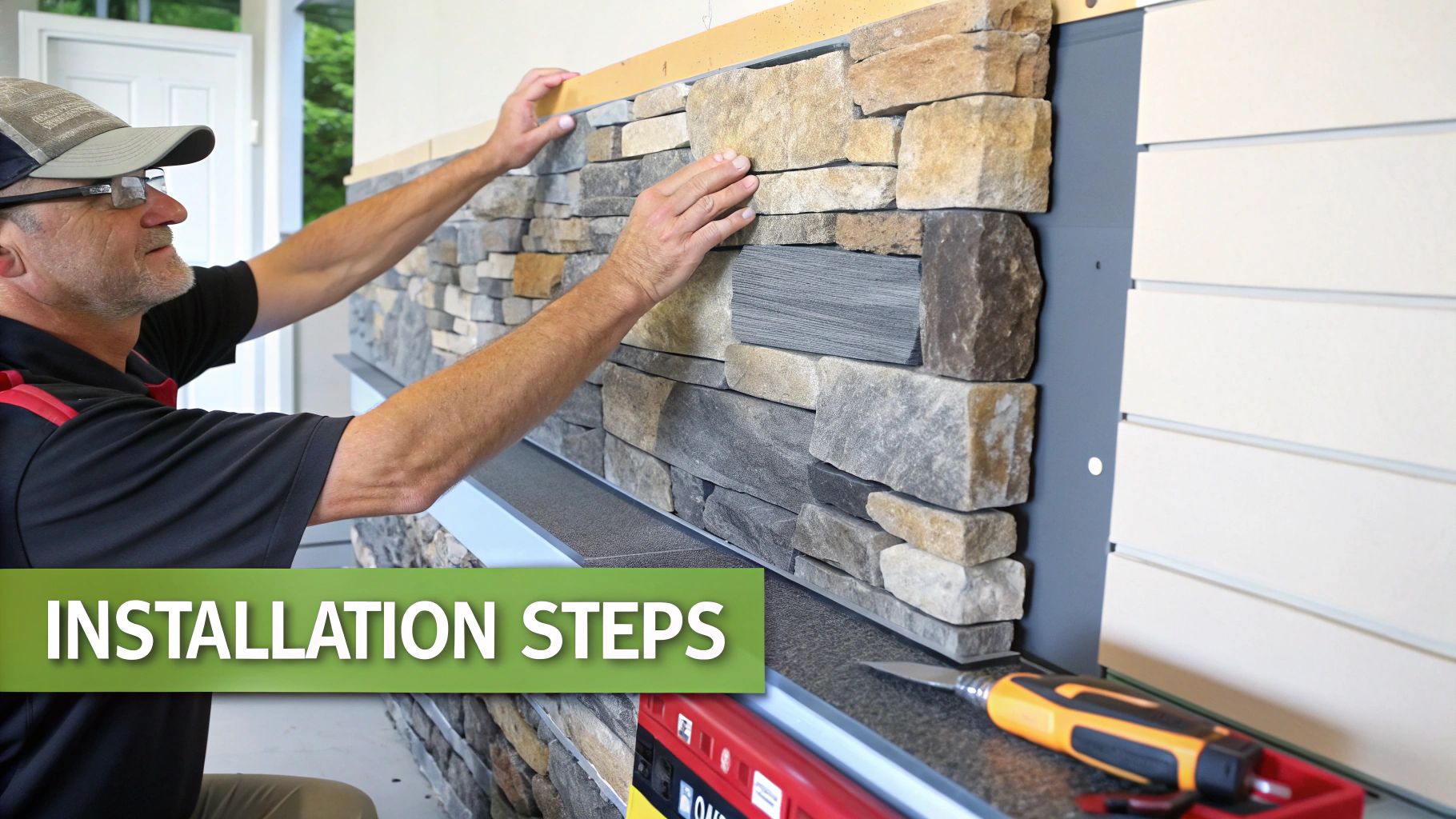
A successful interior rock panel project begins long before the first piece of stone is set. Meticulous preparation isn’t just a recommendation; it's the bedrock that guarantees your stunning new wall will look just as good years from now. Rushing this critical stage can lead to sagging panels, moisture issues, or a visibly uneven finish—costly mistakes that are entirely preventable with a little foresight.
The first job is to assess the wall itself. Is it up to the task? While modern, lightweight manufactured panels are often fine over standard drywall, heavier natural stone might need a more robust backing like cement board to support the weight. Your surface must also be completely clean, dry, and flat. Even small bumps or dips can translate to big problems, disrupting the seamless look you're after.
Think of your wall preparation like priming a canvas before painting. A strong, smooth, and dry surface gives your rock panels the perfect foundation to create a masterpiece that will last for decades.
Finally, think about moisture. If you’re installing panels in a bathroom, kitchen, or basement, a high-quality moisture barrier is non-negotiable. This vital layer stops water from getting behind the panels, which can lead to serious mould growth and structural damage down the line.
DIY Installation or Professional Hire
With your wall prepped and ready, the next big question is whether to install the panels yourself or bring in a professional. The right choice really comes down to the material you’ve chosen, the complexity of your project, and your own comfort level.
DIY (Do-It-Yourself)
Tackling the installation yourself can be incredibly satisfying and budget-friendly, particularly with user-friendly systems like faux stone or Flomary's flexible veneers. These products are designed for easier handling. Still, a great DIY result demands patience, precision, and the proper tools. You’ll need to be confident in your ability to measure accurately, make clean cuts, and apply adhesive just right.
Professional Hire
Hiring a professional installer buys you expertise and peace of mind. An experienced pro knows how to handle the specific demands of heavy natural stone and can anticipate problems before they happen. For larger projects or tricky designs—like wrapping a curved staircase or building a flawless fireplace surround—their skill is often worth every penny. They can deliver that perfect, lasting finish you envision.
To ensure your installation is a success, whether you do it yourself or hire it out, understanding the material's specific needs is crucial. For an in-depth guide, our step-by-step article on thin stone veneer installation covers essential techniques.
Whichever route you take, avoiding common mistakes is key. Rushing the layout, using the wrong adhesive, or forgetting to properly blend panels from different boxes can all undermine the final look. Plan carefully, take your time, and your new rock panel feature will be something you’re proud of for a very long time.
Keeping Your Stone Walls Looking Like New
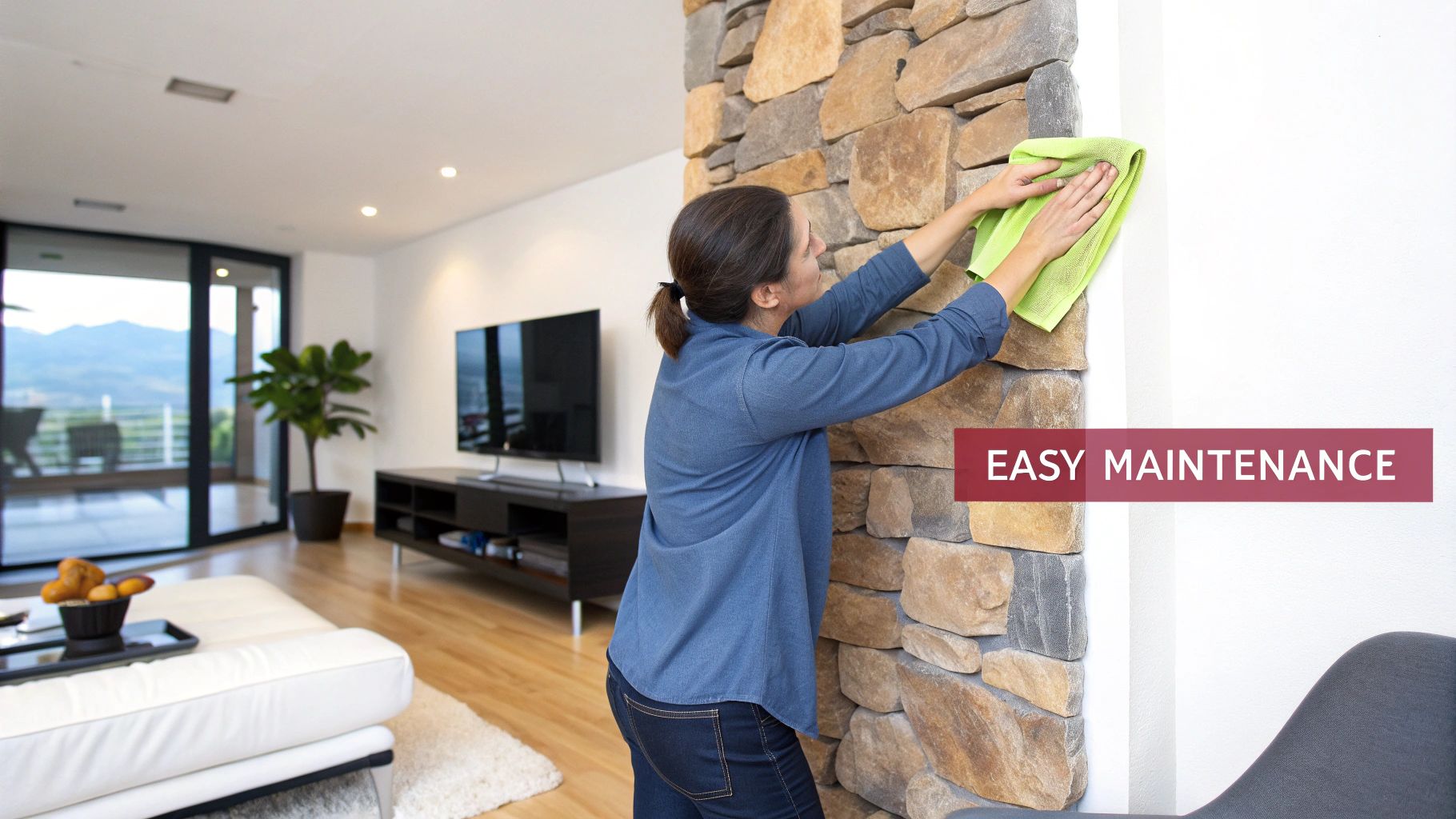
You've made a wonderful choice by bringing the beauty of stone into your home. Think of your new rock paneling as a long-term investment in your property's character and value. To keep it looking as stunning as the day it was installed, all it takes is a straightforward maintenance routine designed for your specific type of stone.
When you're working with natural stone, the biggest concern is preventing it from absorbing stains and moisture. Imagine an unsealed stone is like a very hard sponge; it can still soak up liquids. This is why sealing it right after installation is so important—it creates an invisible barrier that protects the stone's integrity.
With manufactured stone, the approach is slightly different. Here, the goal is to protect the factory-applied colour and finish from fading or damage. This means gentle cleaning is the name of the game, as harsh chemicals can strip away its vibrant appearance over time.
Essential Care for Your Stone Panels
A simple cleaning routine is all that’s needed to keep your feature wall in pristine condition. For everyday dust and cobwebs, a soft-bristled brush or the brush attachment on your vacuum cleaner works perfectly. A quick weekly dust-up stops dirt from settling into the stone's unique textures and crevices.
If you encounter tougher spots or grime, mix a pH-neutral cleaner with warm water. It's crucial to steer clear of anything acidic (like vinegar) or abrasive cleaners. These can easily etch the surface of natural stone or damage the finish on manufactured veneers.
Regular, gentle cleaning does more than just keep your wall looking good. It prevents the build-up of grime that can become difficult to remove later, ensuring the long-term integrity and beauty of your interior rock paneling.
Fixing Minor Imperfections
Life happens, and an accidental scuff or chip doesn’t have to ruin the look of your wall. Specialised patch kits are available for both natural and manufactured stone. These allow you to fill in small imperfections and carefully blend the repair to match the surrounding colour and texture, making the damage virtually disappear.
For natural stone, sealing is the most important maintenance task you can perform. It’s your primary defence against stains and moisture damage. Our detailed guide on sealing stone veneer walks you through the entire process, helping you preserve the raw, authentic beauty of the stone for years to come.
Frequently Asked Questions
Whenever you’re exploring a new design element, you’re bound to have a few questions. Let's walk through some of the most common things people ask when they're thinking about bringing interior rock panelling into their homes. Here are some straightforward answers to help you plan your project with confidence.
Can I Install Interior Rock Panelling Over Drywall?
Yes, you absolutely can in most cases. For the lighter options out there—like manufactured stone or the ultra-thin veneers we’ve developed at Flomary—installing directly onto clean, structurally sound drywall is standard practice.
However, if you've fallen in love with heavier natural stone panels, you need to take an extra step. It’s always a good idea to put up a layer of cement board first. This gives the wall the strength it needs to hold the additional weight safely, so your beautiful new feature wall stays put for years to come. When in doubt, always follow the manufacturer's specific instructions.
Is Rock Panelling a Good Choice for Bathrooms?
It can be a fantastic choice, but the key is picking the right material. A bathroom is a demanding, high-moisture space, so your panelling has to be up to the task of handling steam and splashes.
This means you should either go with a non-porous material like manufactured stone or commit to properly sealing natural stone. A high-quality sealant will create a protective, waterproof barrier that stops water from seeping in, preventing stains and mould. This is how you get that stunning, spa-like atmosphere without creating a headache for yourself down the road.
A key takeaway is that the perceived value of a home can be significantly boosted by well-executed upgrades. A study of design trends shows that unique architectural features like a stone accent wall are often highlighted in real estate listings as a major selling point, signaling quality and permanence to potential buyers.
How Does Faux Stone Cost Compare to Natural Stone?
Generally speaking, manufactured stone (often called faux stone) is the more budget-conscious option. The cost savings really come from two places: the price of the material itself and the lower cost of labour to install it.
Because it’s so much lighter, faux stone is quicker and simpler to put up. You can often skip the expensive structural work that heavy natural stone demands. Natural stone commands a premium price for a reason—its one-of-a-kind geological beauty, the costs involved in quarrying it, and its incredible durability make it a true long-term investment.
Ready to transform your space with the timeless beauty of stone, but without the weight and hassle? The innovative, flexible stone solutions from Flomary make it possible. Explore our collection and get a free consultation today at https://flomary.tr.

